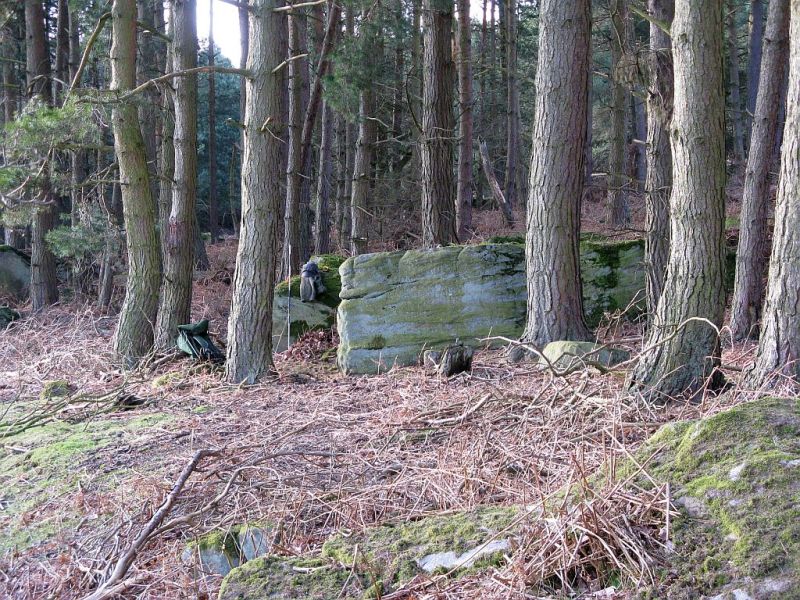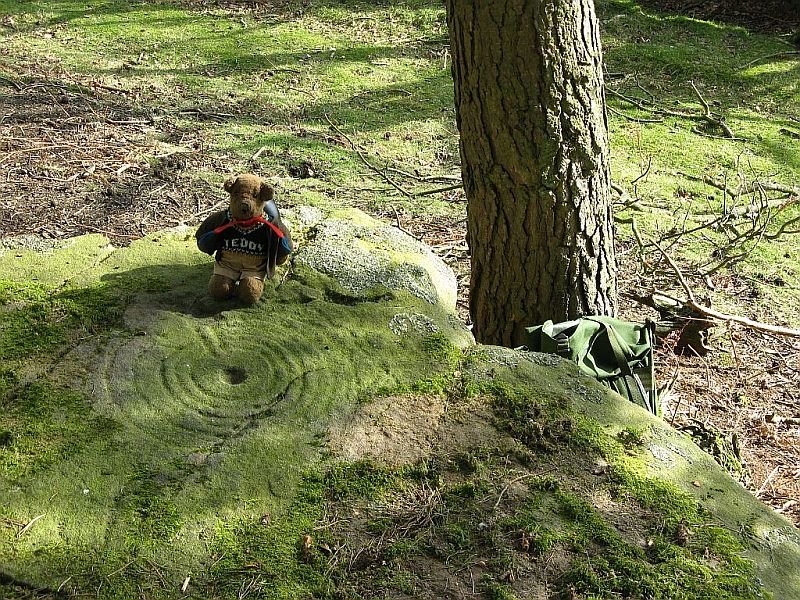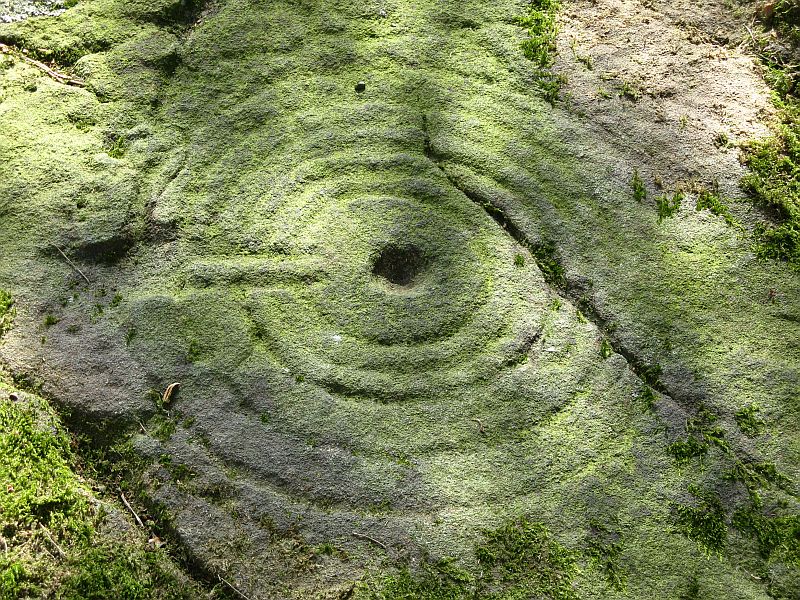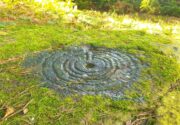Cup-and-Ring Stone: OS Grid Reference – SE 14250 81756
Also Known as:
-
WAP 8 (Brown & Brown)
Getting Here

From Masham, head westwards along the country lanes to Fearby village (passing the old cross on the green), through old Healey village (where once stood four stone circles, seemingly destroyed) and onwards to Gollinglith. From here, keep going up the winding steep lane until you’re at the top where, on the right-hand side of the road, a footpath takes you diagonally northwest over the uphill fields. When you hit the walling which leads to the woods, follow it up and, once at the corner of the trees, follow the track back eastwards along the wall edge, keeping your eyes peeled when you pass the second line of walling that runs down the slope. You’re damn close!
Archaeology & History
One of a cluster of fascinating carvings in this remote region of the upland Dales, this is perhaps the most impressive multiple-ringed carving of the group, known collectively as the West Agra Plantation group. The carving was rediscovered sometime in 2002 by Emily McIntosh and was described by Brown & Brown (2008) thus:
“This boulder measures 5.5 x 3.1 x 1.28m and has a multiringed motif 50cm in diameter linked by a number of grooves and isolated cups.”


But this barely does the stone justice. The main focus is on the cup with six surrounding rings, intersected by an intrusive double-line from outside the series of rings then running into the central ring itself — though not touching the focal cup at the very centre. This double line points to the southeast and is somewhat akin to a sliver of light running to or from old solar designs. It is a little bit like some aspects of the carved stones found on Ilkley’s Panorama Stones (though Ilkley’s carvings are much fainter). At the end of the intrusive double-line is a small cluster of cup-marks. There’s also another curious singular carved line running outwards from the third ring, running out of the concentric rings then heading off further down the stone. More cups and lines scatter other parts of the stone and there may be another faint line running from near the central cup all the way out of the rings close to the main ‘ray’ of lines.

A large standing stone can be seen if you walk a few hundred yards east along the side of the wall. It’s quite impressive.
Apparently the woodland in which this carving (and its associates) can be found is supposedly ‘private’ and one is supposed to contact some group calling itself Swinton Estates to set foot in the woods. Not the sorta practice we usually put up with in Yorkshire. If anyone has their contact details, please add them below in the event that anyone has need to ask ’em about going for a walk here.
References:
- Brown, Paul & Barbara, Prehistoric Rock Art in the Northern Dales, Tempus: Stroud 2008.
Links:
- Agra Wood Rock Art – more notes & images
Acknowledgements: For use of their photos, many thanks to Geoff Watson; and QDanT and his Teddy!
© Paul Bennett, The Northern Antiquarian
The map could not be loaded. Please contact the site owner.
Any chance of knowing which direction the ”intrusive” double line is facing?
Short of going up there myself and taking a look at location…high up above sea level, or low down? difficult to say, but my first impression, given my obsession with astronomy and astro meteorology is that six rings= six major bright planets travelling around in the sky, the intrusive line is an instruction to line up the post that belongs in the middle with the eastern horizon at sunset or rise, and this could be a prehistoric precursor to the astrolabe, but before Atlas divided the sky into twelve portions?
There are tales in my Indian books on astrology of how ancient seers would estimate ghatikas ( 24 minutes of time) to calculate nadis, an essential system of forecasting using constellations, using exactly the same method of putting a pole in a hole in the ground and watching how the sun hits it at various parts of the day, but also watching stars?
Is the intrusive bit pointing east or west, or could the stone have been moved from its original place?
Compass directions, when it’s possible to give them, might yield essential clues to understanding the nature of these stones do you think?
Hi Tricia –
Odd that you asked when you did. I’ve just edited it, as I knew summat was missing. The lines runs out of the central cup to the southeast.
We’re going up to have a look around the West Agra stones in the coming weeks, as there’s other prehistoric remains nearby which haven’t been documented by archaeologists (surprise surprise!).
All the best – Paul
There is no ‘supposedly’ about the status. Swinton Estate can be contacted on 01765 689224. Agra Moor is part of Jervaulx (Clifton) Estate. The locals (read farmers & gamekeepers) are naturally suspicious of intruders & tend to assume that the intention is that of theft, desecration or more wretched mushroom gathering.
Emily’s Dad.
Hi “Emily’s dad”! – Weird that locals are “naturally suspicious” of people. That aint usually the way of country folk in my experience – which is very extensive. Where “suspicion” occurs, I’ve always found summat to be going on that shouldn’t be. Like with the gamekeeper illegally shooting & trapping badgers, foxes, etc, or having other traps to prevent ‘vermine’ as some idiots like to call the indigenous wildlife. Funnily enough, when I was last up here a coupla years back, a pile of dead badgers was found at the top of the woods, explaining why the “private” signs were out again. I’m pretty sure it was illegal – but mebbe people should ask Jervaulx (Clifton) Estate about the issue? Or the RSPCA? Not sure misself, but at the time I thought I’d best not trouble the suspicious locals, just in case we might need to cut a deal with ’em in our rambles hereabouts in the future. Oddly enough, a couple of locals we did meet were very friendly & didn’t seem to care much about us walking hereby. They seemed very normal people. Cheers for the contact details though. V.helpful. – P.
In speaking with SEPA employees yesterday, they informed me that culling of badgers in Agra’s ‘private’ woodland apparently violates British law & environmental law – and that info needs passing to RSPCA & EA. It might be good to tell the Estate managers about it. I’ll pass on specific details about this illegal practice when I revisit the woodland & take photos in Springtime. I assume of course, that the traps & piles of animals at the top-end of the woods will be moved by then. But we’ll find them! Having worked as a ranger in the past proves very helpful with such matters. If you could find out who ordered the culling, that would be helpful. Cheers – P.
‘Emily’s Dad’ was not meant to be taken as a pseudonym!
Emily McIntosh, one of my daughters lived at West Agra & it was she who alerted me to the presence of some of the stones thereabouts. Later I took the tenancy of Low Agra where I lived & farmed for seven years. During that period I contacted archaeological surveyor Tim Laurie & together we plotted & recorded many of the stones as well as the Romano/British camp near High Agra.
If any of you become aware of wild life crimes please call PC Gareth Jones on 07909 686508. Gareth has had some successful prosecutions in this area & any assistance to reduce these abominations would be welcomed. Although he is based in Ripon, he covers a huge area of North Yorkshire.
My own experience of rural crime tends to make me wary: At various times & in no particular order, I have had all my heating oil stolen, daughter Sophie & her partner Howard have had sheep stolen – the most recent batch only last week – My late father in law David had a stock trailer taken… need I go on? I’m aware that many of the criminals are relatively local, but also that others visit from the conurbations.
Regards, Neil McIntosh.